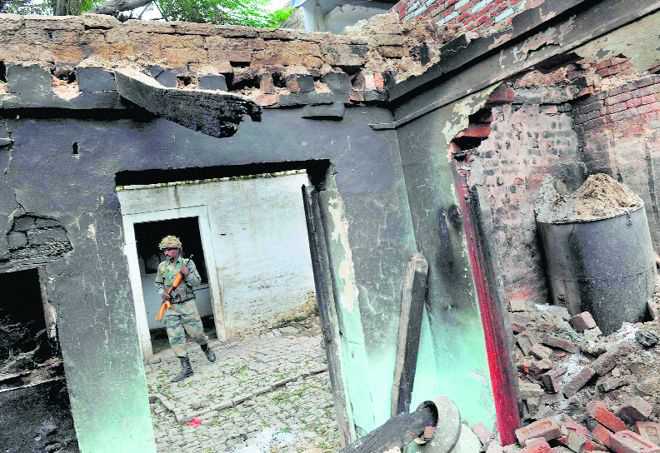
MOBOCRACY: The book dissects the massacre of Muslim residents of the Gulberg Society in Ahmedabad in 2003 and out crawl the worms of communal mobs, police connivance, political protection for the attackers, victimisation of the families of victims and judicial myopia
Roopinder Singh
We, the people of India, gave ourselves our Constitution. “Fraternity, our common sisterhood and brotherhood would, if fully realised, result in a seamless oneness, or unity, amid the almost limitless diversities of this country. This is the ideal we the people of India wrote into our Constitution and then forgot,” says the former bureaucrat and social scientist, who is the author of this disturbing book.
Indeed, the social situation in the country is worrying. We have, as the author points out, badly battered our commonalities and even the basic principles of fraternal co-living — public civility and public fairness. The book opens with the infamous massacre of Muslim residents of the Gulberg Society in Ahmedabad in 2003. The tragedy is dissected with care, and out crawl the worms of communal mobs, police connivance, political protection for the attackers, victimisation of the families of victims and judicial myopia. Unfortunately, we are all too familiar with the dirty, stinky worms that have eaten into our constitutionally-mandated quest for the ideal of unity amidst diversity in our country.
We see bloody streaks of collective vengeance in the killing of citizens transporting cows, in attacking minority neighbourhoods and in targeting religious communities, their prayer gatherings and so on. The nationalising of the Gujarat model has turned traditional values on their head. “Modi’s vision is tenaciously majoritarian, hostile to religious minorities, equivocal about social equality for the Dalits ...” says the author.
Ghar Vapasi implies that the Hindu faith is the home to which Christian and Muslim prodigals, who strayed by converting to other religions, need to be brought back. There is little to dispel the notion that such conversions are not by heart but rather because of economic and social compulsions. This sets the stage for a tussle for acquisition of souls in between the pandits, maulvis and the priests.
The high-decibel, aggressive assertion of Hindutva is supported by right-wing politicians, especially during state elections. Yogi Adityanath declares “For every Hindu converted, 100 Muslim girls will be converted in retaliation.” A Cabinet minister participated in the funeral of a man accused of lynching a Muslim for unproved allegations of eating beef. The murder accused’s body was covered with the National Flag.
In this post-truth era, no one wants to ascertain the facts, why bother when mere accusations serve the purpose. The killing of Pehlu Khan is a case in point. Mewat in Haryana is a dairy-rich area, and many of the dairy farmers are Muslims. On April 1, 2017, a grey-bearded, visibly Muslim man, was attacked by a mob on a busy national highway in Alwar, Rajasthan, and grievously injured. He succumbed to his injuries in a private hospital two days later. His family barely has an acre of land and depends on milch cattle — cows and buffalos — for milk to sell. Naturally, they trade in cattle, buying and selling the livestock. Pehlu Khan and his associates had bought cows and were transporting the animals when they were attacked, mercilessly beaten, their money stolen. They were saved, in the nick of time, by the police. Following a massive national outrage, some assailants were arrested. And when one of them died in prison due to illness, he was “cremated with his body wrapped in the National Flag, in the presence of a union minister.”
Extrajudicial killings have ceased to provoke outrage from the public at large. This is because the accused are first demonised and then killed. Given the present atmosphere, is it a surprise that such killings often target Muslims? Incidents of terrorist activities are often pronounced to be the handiwork of Islamist terror groups. This bias was exposed by Hemant Karkare, a police officer, who found that the 2006 Malegaon blast was the handiwork of Hindu terror groups. Although the victims — 37 dead and more than 100 injured — were Muslims, the investigators assumed that the perpetrators were Islamist militants.
Love jihad, or targeting of interfaith couples by vigilantes; targeting Kashmiri students and questioning their loyalty to the nation; attacking anyone who does not subscribe to a narrow hyper-nationalistic view espoused by the ruling party... all these are familiar manifestations of the rising intolerance that is causing rents in our secular fabric, one that allowed different colours of faith and tradition to embroider the weft and warp of our national fabric.
Social media has a proven ability to bring out the worst impulses in us. The worry is always of how it will further narrow the funnel of our prejudice and block the light of compassion and righteousness with which we must guard the universal values that our Constitution embraces. Voices, as reflected and quoted in this book, are needed to make us introspect our duties as Indian citizens and as human beings.



























